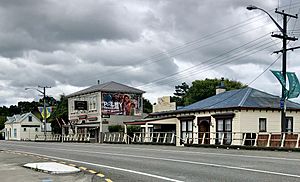Turakina, New Zealand facts for kids
Quick facts for kids
Turakina
|
|
|---|---|
 |
|
| Country | New Zealand |
| Region | Manawatū-Whanganui |
| District | Rangitikei District |
| Wards |
|
| Electorates |
|
Turakina is a small, historic village in New Zealand. It is located on the North Island, southeast of Whanganui city. The village gets its name from the Turakina River. This river flows from south of Waiouru all the way to the sea.
Turakina is famous for something very special. It was the home of New Zealand's first-ever children's health camp! This camp was started by Elizabeth Gunn in November 1919.
Contents
History of Turakina
Early Māori Settlers
The first people to live in the Turakina area were the Kahui Rere and Kahui Maunga tribes. Later, they became known as Ngā Wairiki. Over time, another tribe called Ngāti Apa moved into the area. They came from the Bay of Plenty and settled near the Rangitikei River. Many Ngā Wairiki and Ngāti Apa families married each other. This led to the Ngāti Apa tribe becoming very strong in the region.
Today, a group of Ngā Āriki people, who are part of the original tribes, still live in Turakina.
European Arrivals
In the 1800s, many Scottish settlers came to Turakina. Their families still live there today. Many Māori families also married Scottish settlers. This created a unique mix of cultures.
The Scottish heritage is still very important in Turakina. For example, the village hosts Highland games every year. These games happen in late January. They attract many people from all over New Zealand.
Turakina's Special Health Camp
As mentioned, Turakina holds a special place in New Zealand's history. It was where the country's first children's health camp began. This camp helped children who needed extra care. It was a big step forward for children's health in New Zealand.
Meeting Places: Marae
A very important place in Turakina is the local Tini Waitara Marae. A marae is a traditional meeting place for Māori people. The Te Horo Taraipi meeting house is also part of this marae. It is a special gathering spot for the Ngāti Apa tribe.
Life in Turakina
The Turakina area is home to a small community. It includes nearby places like Koitiata, Rātana Pā, and Whangaehu. In 2018, about 1,254 people lived in this area.
Education in Turakina
Turakina has its own school called Turakina School. It is a public primary school. Students from Year 1 to Year 8 attend this school. It is a co-educational school, meaning both boys and girls learn there.


